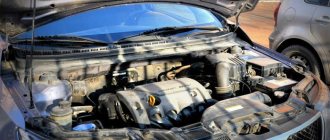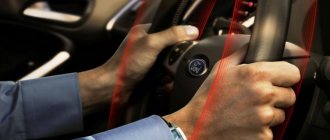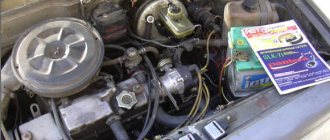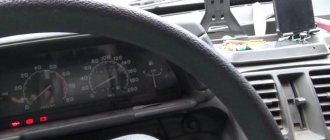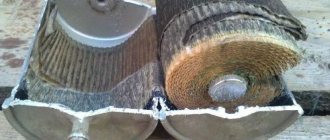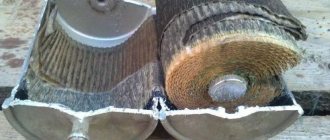The problem is when car stalls when braking This can happen to both the driver of a carburetor and an injection car. In addition to inconvenience, such a malfunction can also lead to an emergency. After all, the car can stall not only during sharp braking, but also when turning or in front of an obstacle. Most often, it is drivers of cars with a carburetor who encounter this problem. However, modern fuel-injected cars are not immune to this problem. Reasons why the engine may stall when pressing the brake pedal there may be several - malfunctions in the operation of the vacuum brake booster, depressurization of its hose, problems with the fuel pump or idle speed sensor (for injection ones). In this material we will provide you with the necessary information, which will help you troubleshoot the problem yourself. But you will be able to identify the true cause of the breakdown only after an inspection and detailed diagnostics of the machine.
Often such a breakdown indicates a malfunction of the brake system, so we do not recommend using your car until it is fixed. This will protect you from creating emergency situations on the roads.
A little theory that is important to know
Situations when a car stalls when braking happen quite often and this does not depend on the brand of the car.
Two conditions contribute to the emergence of such a situation - the transition of the engine to minimum speed (since the gas pedal is released) and the creation of an additional load on it - the brakes, slowing down the wheels, also create a force on the transmission elements, and accordingly on the power unit.
Despite the fact that the driver stops acting on the accelerator, the power system (injection, carburetor) continues to perform its function - it prepares the air-fuel mixture in the required proportions and quantities, and then delivers it to the cylinders, due to which the engine operates under the above conditions - minimum speed and load resulting from the use of brakes.
But if the proportions of the combustible mixture are violated - it is “lean” or “rich”, then the engine simply will not be able to operate on it.
As a result, the main reason why a car stalls when braking is that the air-fuel mixture does not match the operating conditions.
Diagnostics of VUT
It's very simple. To check the vacuum brake booster, just press the brake pedal several times with the engine off - 5-7 presses are enough. Each subsequent press will be tighter than the previous one. Then, with the brake pedal depressed, you need to start the engine. The pedal should fall under your foot.
If this is exactly the case, then VUT has nothing to do with this situation. He's perfectly fine. If, after starting the engine, the pedal did not fall, but remained in place, then you need to carefully visually inspect the hose, the vacuum booster membrane and other elements of this system.
Uncharacteristic cases
If the vacuum booster and power system have been checked, but the cause has not been found, consider non-trivial situations encountered in the practice of auto electrician diagnosticians.
If the engine mounts on a car are heavily worn, then sharp braking will cause it to shift relative to the body. Under the right circumstances, such a displacement can provoke a breakdown in contact in the connections of sensor equipment and actuators. Wires with frayed insulation may short to ground or short circuit with each other, which will cause the engine to stop.
Brake booster pipe
A very important role in the entire structure of the power unit is played by the vacuum booster tube with a valve built into it. With its help, the necessary vacuum is created in the intake manifold of the engine, which ensures the correct formation of the air-fuel mixture. If the valve malfunctions, an increased vacuum occurs in the manifold, which greatly depletes the mixture, as a result of which the car immediately stalls when the brake is pressed sharply. If the hose leaks, excessive air leaks into the manifold, as a result of which the mixture becomes excessively rich, which prevents the normal functioning of the engine. This also makes him go deaf.
Carburetor and fuel pump
On carburetor engines, the air-fuel mixture is influenced by two components - the fuel pump and the carburetor.
Motors with this type of power supply use a mechanical vacuum pump. If a membrane rupture occurs in it, the unit simply will not be able to pump the required amount of fuel.
If the membrane is severely damaged, the pump stops flowing completely, but if the break is insignificant, this will affect its performance.
At high speeds, the amount of fuel pumped may be quite sufficient for the normal functioning of the engine, but at low speeds there will not be enough gasoline (the same “leaning” of the mixture occurs).
The carburetor can cause the car to spontaneously stop when braking due to:
- Incorrect adjustment of idle speed (idle speed);
- Clogged channels of the XX system;
- Malfunction of the XX solenoid valve;
- Air leakage at the junction of the carburetor and the intake manifold.
For the most part, the “fault” of a stalled car when braking is problems in the operation of the idle system, and they can be solved by thoroughly flushing the carburetor, checking and replacing the solenoid valve.
Summarize
As you can see, there are many reasons why this problem occurs on a car. In such situations, the most optimal solution for injection engines is computer diagnostics. If it is an old car equipped with a carburetor, then you need to visit specialists to set them up. This should solve the problem.
It should also be taken into account that a lack of fuel, which can occur during braking and causes unstable engine operation, is often associated with a clogged fuel pump grid. To solve the problem, change or clean the mesh.
If there is a lot of dirt in the car’s fuel system, experts do not recommend using various popular additives to flush it. The thing is that the cleaner will only soften the deposits, which will then clog everything that is possible.
The car starts on auto start and then immediately stalls.
If the car does not start from auto start, check the car alarm
Also, the car can start from autostart and immediately stall. Don't panic. Perhaps the reasons why this happens are:
If the car starts from autostart and immediately stalls, the cause may be a sharp cold snap outside.
- It's getting cold outside. Fuel does not flow to the injector. Spray a special cleaner into it and start the engine. A low-quality mixture is supplied to the cylinders. Faulty alarm . Worn out or old motor.
Influence of unaccounted air
For normal engine operation, the composition of the air-fuel mixture (AFM) should not be much more or less than the stoichiometric composition - 14.7 portions of air to 1 portion of fuel. To adjust the injector open time, it is important for the Engine Control Module to know the amount of oxygen entering the cylinders during the intake stroke. Calculation methods differ in the type of sensors, based on the readings of which the weight of the air charge is calculated.
- An absolute pressure sensor (MAP) paired with an air temperature sensor (ATS). The ECU fuel maps contain the flow area of the engine intake system. Based on the vacuum level in the intake manifold and the air temperature, the engine control unit can adequately calculate the mass of the fresh air charge.
- Mass air flow sensor (MAF). The sensor is based on a heater installed in the intake tract after the air filter. The heater temperature is maintained at the specified level. The stronger the airflow, the more current is required to maintain the temperature of the heating element. By measuring the current, the ECU calculates the amount of air entering the intake tract.
If the actual amount of air entering the cylinders is greater than the calculated value calculated by the ECU based on the readings of the mass air flow sensor, the composition of the fuel injection system will be disrupted. Therefore, the engine stalls when the brake pedal is pressed if there is a leak in the vacuum system.
Reasons for interruptions
- Insufficient fuel pressure. Loss of fuel pump performance, malfunction of the bypass valve, clogged coarse and fine filters lead to a decrease in fuel pressure and the appearance of inertia in the fuel supply. Therefore, from the moment the fuel pump is turned on and the injectors open, enough time may pass for the revolutions to drop below the threshold values. In some cases, due to lack of fuel, the car stalls or jerks.
- Contaminated or faulty injectors. Due to deposits and soot, fuel atomization is disrupted and, as a result, the completeness of combustion of the fuel injection pump. But a much more serious problem is a hanging injector, which does not close completely and allows gasoline to pass through into the cylinders. In this case, the car stalls in transition modes due to over-enrichment of the mixture.
- Worn or dirty idle air control. IAC is extremely important for stabilizing idle speed and regulating the amount of air entering the intake when the throttle valve is closed. If the electric motor of the regulator is worn out, or the movement of the rod is difficult due to carbon deposits, the engine may stall when the gas is suddenly released or powerful electrical consumers are turned on.
- Dirty throttle valve. Oil deposits and carbon deposits not only reduce the cross-section of the compensation gap laid down by the engineers, but also lead to jamming of the throttle valve.
RXX
IAC or idle air control is a device whose main task is to maintain a certain number of crankshaft revolutions when the throttle is fully closed. That is, when the driver takes his foot off the gas pedal, the engine idles. If there are any problems with the IAC, the engine speed at XX will fluctuate. These vibrations are clearly noticeable after the gas pedal is pressed sharply.
If you suspect an IAC, the first thing you should do is check the element and its control circuit using a multimeter. Replacement is recommended to correct the problem. Repairing the IAC is not practical.
The reason is the fuel pump and fuel filter.
An equally common reason for a car stalling during heavy braking is, according to statistics, a malfunction in the fuel pump or a clogged fuel filter. It is as a result of this that the engine does not receive enough fuel to operate, so it stops and the car suddenly stalls while driving. If it is definitely established that the main culprit of everything that is happening is the fuel filter, it will have to be replaced with a new one, but the fuel pump, it is possible that it will be possible to clean or repair it, after which it will work normally again. A pressure gauge will help you check whether the fuel is supplied normally and whether the actual indicator corresponds to the required parameters.
Checking the operation of the fuel pump
Even minor pump failure has a negative impact on engine performance. The car slowed down sharply - the idle speed worked. For a certain period of time, the fuel stops flowing, and then the supply resumes. It is at this time that gasoline may stop flowing and the car stops.
A supercharger is located near the carburetor. You will need to loosen the clamp located next to it a little. Then the fuel is pumped manually. This operation will need to be done several times. The pump performance indicator is the pressure exerted on the finger. If the pressure is high, work will be required to replace the filter and clean the pump.
A complete lack of pressure indicates that the gasoline pump is not working. It needs to be replaced with a new spare part.
Automatic transmission
Owners of cars with automatic transmissions also periodically encounter the fact that the car stalls when braking. Automatic or manual – it doesn’t matter at all, because it’s not about the gearbox at all.
The first step is to check for errors. The car itself will tell you what happened to it. And if there is a problem with the automatic transmission, the driver will quickly find out about it. If the fault were related to the torque converter, the engine would stall in various selector positions except neutral.
If the car stalls when braking, there is no need to touch the automatic transmission - you can change the oil in it. And all the systems described above should be diagnosed - the fault is hidden in one of them.
Why does the car stall when braking: the main reasons for the engine stopping
Many car enthusiasts, when starting the engine, believe that it works without any problems and immediately gains the necessary characteristics for uninterrupted operation. After a short warm-up, the car starts normally, but when braking, it stalls, most often at the moment when the clutch is depressed.
To understand the situation, just look at the tachometer or listen to the sound of the engine. When you press the clutch, the speed drops abruptly to a minimum level at which the engine stalls. Moreover, such a problem may occur only occasionally, which complicates the identification of the malfunction. The engine may stall when braking without pressing the clutch, or simply when braking the engine.
From this we can conclude that the car stalls in transient modes when the gas pedal is released and the throttle valve closes. At this moment, the idle system begins to work, but this does not mean that it alone is responsible for the problem that has arisen.
If the car stalls while braking, the first thing to check is the condition of the braking system. To do this, you need to pump the pedal five to six times and leave it depressed to the bottom point. This is done with the engine off, after which it starts, and the pedal should rise to its normal functional state, and the brakes should engage normally. If this does not happen, the brake system needs to be diagnosed and repaired.
Experts include the following reasons why the engine stalls when braking:
- breakdown of the brake vacuum booster, its depressurization;
- a burst and depressurized vacuum booster hose;
- in engines with fuel injection, the idle speed sensor may fail;
- failure or problems with adjusting the throttle position sensor or its clogging;
- tank clogging or fuel pump failure.
Problem with idle speed sensor
There are often situations where a cold engine starts easily and idles perfectly. But when you start driving and depress the clutch, the engine speed drops sharply and the car stalls. To identify the root of the problem, you need to take your foot off the gas while the car is coasting, depress the clutch and press the brake pedal. If at the same time the engine speed drops, this indicates a problem with the idle speed sensor; it needs to be adjusted or replaced.
This is due to the fact that when you sharply press the brake and take your foot off the gas pedal, the system goes to idle, for which the idle speed sensor is responsible. If it malfunctions, the engine does not switch to the desired mode, the speed drops abruptly, and it stalls.
Why does the engine stop working?
A running engine is not always able to work efficiently and uninterruptedly throughout the entire journey. Among the main reasons for stopping the operation of the power unit:
- VUT malfunction, hose rupture;
- breakdown of the pump responsible for pumping fuel;
- malfunction of the control unit or breakdown of the idle speed control sensor.
There are also other reasons. When the car stalls while braking, the car owner should check the condition of the system responsible for braking the vehicle.
Depressurization of the vacuum booster hose
This hose serves to connect the amplifier to the intake manifold. Violation of its integrity may cause the engine to stall during sudden braking. As a result of wear or mechanical damage, cracks appear in the hose, into which air enters. The result is a violation of the proportion of the air-fuel mixture for the engine, for which the intake manifold is responsible. When you press the brake, especially sharply, it becomes critically lean, the engine speed drops and it stalls.
Checking the hose is quite simple. It is disconnected directly from the VUT, the car starts, and the hole is tightly closed with a finger. If the hose is intact, the engine speed will increase noticeably; if breaks and cracks appear, it will continue to suck in air and the speed will remain at the same level.
The VUT vacuum valve is also checked in this way; you just need to disconnect the hose from the other side. If it breaks, even if the hose is intact, air will enter the system, which will lead to the problems described above with engine operation. Diagnostics comes down to finding the place where excess air is sucked into it.
Option with injection engine
During sharp braking, an injection engine can also stall, for example, if the injectors do not have time to close. It is also possible that the injectors become clogged, which is why they do not close completely, as a result of which the engine “overflows” and it may stall.
In this situation, it is recommended to drain the engine oil and then wash it. Then add gasoline with additives to clean the injectors. Perhaps flush the tank. In this case, to avoid clogging of the filters and nozzle, you need to blow out the fuel line.
The causes of this problem can be very different and affect different nodes. In some cases, if you have the opportunity and desire, you can try to fix everything yourself. But if the car stalls when braking and you have doubts about your own abilities, it is advisable to turn to specialists and not put it off.
The situation when the engine stalls when you press the brake pedal is familiar to many car owners. With such a malfunction, the power unit may stop working at the most inopportune moment, creating inconvenience and a certain danger on the road. For this reason, it is recommended to stop further operation of the vehicle until the problems are resolved.
If the engine stalls when you press the brake, you can not only find the cause yourself, but often eliminate it yourself. In this article we will talk about why the engine stalls when braking, as well as what to do if the engine stalls during heavy braking.
Read in this article
Failure of VUT or hose
Each of the listed reasons due to which the car stops moving when braking should be considered in more detail. And first of all, you need to start with a possible breakdown of the VUT. A problem may also be a rupture of the connecting hose material, leading to its depressurization.
VUT is a special vacuum-based brake booster. With the help of this device, it is possible to alleviate the efforts that the car owner spends when pressing the appropriate pedal, wanting to stop the car. The device is located between the cylinder and the pedal, which is responsible for braking the vehicle.
The VUT is connected to several engine structural elements - a hose and a fuel intake manifold. Additionally, the amplifier is equipped with a membrane, damage to which can lead to engine shutdown.
In the event of a faulty membrane, if the car owner presses the brake pedal, the part will not be able to organize the necessary air vacuum, which is why the remaining gases will become part of the fuel mixture. As a result, the engine stalls. You can find the problem yourself. To do this, you need:
- Lower and raise the pedal responsible for the brake 5-6 times.
- Secure it in the lowered position.
All actions are performed with the engine not running. When everything is done, the engine will need to be started. If the part does not take the standard position and the brakes do not engage in the standard mode, it means that the membrane has indeed failed.
There is another option for checking the performance of the membrane
- After running the engine in neutral, the car owner needs to press the brake pedal and immediately turn off the engine.
- There is no need to take your foot off the pedal for 30 seconds.
If over the elapsed time the pedal does not try to take the standard position and does not resist pressing, then the VUT is working. If the opposite results are found, you will need to disassemble the braking system to continue troubleshooting.
Since the VUT is connected to a hose connecting the device to the fuel intake manifold, problems can sometimes arise in the hose itself. The rupture of the element and its depressurization cause a decrease in engine speed. As a result, the car stops abruptly, stalling.
It is noteworthy that the amplifier is usually completely replaced, and many auto repair shops are not even ready to repair this device. The replacement cost is quite high. It is not recommended to perform the procedure yourself, as there may be a risk of system breakdown.
Checking VUT hoses
Often, when a car stalls when braking, the reason is precisely the broken seal in the connections. Checking how the hose feels is quite simple. You need to disconnect it from the vacuum booster and then start the engine. After this, the resulting gap in the hose is closed with a finger. If the hose tightness is normal, then the engine speed will increase. If there is suction of unaccounted air in the hose, there will be no reaction to these diagnostic actions. In addition, it is important to check the vacuum valve - it is located on the side of the VUT hose that should be connected to the amplifier. If the valve is inoperative, even sealed hoses will trap air.
If the VUT is faulty, then it is much easier to install a known good one or a new one instead of the broken one. Repairing a vacuum booster is often impractical. In addition, repairs require certain specific knowledge. Not all specialists agree to restore this unit.
Why the car stalls while driving: the main reasons
There can be many reasons for a sudden engine stop while driving: from the most trivial (running out of fuel) to complex malfunctions of the power unit. Some problems arise only in carburetor engines, others - in injection engines. And it also happens that the car stalls while driving for reasons that arise in both types of power units. All these problems are worth considering in more detail.
Poor quality fuel
The fact that this is the reason for the sudden stop of the engine can be understood if the problem arose after you refueled. Moreover, the motor may not stop working immediately, but after some time. Usually, the “triple” or twitching begins first. Sometimes after stopping the engine it is possible to start again, but then history repeats itself. There is only one way out - wait until the refueling is normal, buy high-quality fuel to replace the filled one (you also need to install a new fuel filter).
No fuel supply
The main culprit here is most often the fuel pump. If it is located in the gas tank (for example, like in the VAZ2109-15), then it is very simple to understand whether it is working or not: turn on the ignition and listen: a soft buzzing sound should appear from behind. If it is not there, the fault should be looked for in the power supply circuits of the fuel pump (check the integrity of the fuse and relay) or in the pump itself. However, it also happens that the device buzzes, but still does not pump. To be sure of this, you can remove the hose going to the carburetor or fuel rail and disconnect it: if gasoline under pressure sprays out, it means the pump is working. For injection engines, poor fuel delivery may be due to dirty injectors and throttle valves. In such a situation, stationary service is necessary - this cannot be done on the road.
On some car models, the tank has a flat design and is located horizontally. With a small amount of fuel (less than 10 liters) and going uphill, the fuel pump is not able to capture the next portion of fuel and the car begins to stall.
Inertia of injectors on an injection machine
Cleaning a removed injector
In the case of an injection engine, the reason lies in the inertia of the injectors. They do not have time to close at the moment of sudden braking, and fuel overflows under the piston, preventing the occurrence of a spark. As a result, the engine stalls. This suggests flushing (with high-quality gasoline) the fuel equipment and purging the line to prevent dirt from re-entering the filter nozzle nozzles.
So the function of an injector, for example VAZ-2114, is tied to sensors:
- Throttle valve position (TPV).
- Mass air flow (MAF).
- Coolant temperature (CLT).
- Crankshaft position (CPCP).
The first is designed to regulate the volume of air supplied to the engine. The cause of the malfunction is sticking of the damper, mechanical wear with jamming and cutting off the supply of the combustible mixture . A sensor defect is determined with a multimeter to identify a problem in the electrical circuit. The sensor must respond to gas supply. Lack of response leads to replacement of the device.
The second factor in stopping the engine is excessive gasoline consumption, especially when the accelerator pedal is depressed, that is, the gas is pressed or released. The situation boils down to an increase in the amount of air, which becomes a sign of a lean mixture and the engine stopping. The problem is solved by cleaning the sensor.
The third reason occurs when the engine is warm, that is, when a rich mixture is supplied. In this case, the sensor does not produce the correct proportions of fuel, and the engine may stall.
The fourth reason is checked with an oscilloscope, which is rarely used when replacing the sensor with a new one or a working one. With a faulty DPKV, poor ignition is observed and it is difficult to start the car. The engine stalls if you don't give it a choke.
Engines also stall if the head gasket is defective.
Depressurization of VUT or its hose
The vacuum brake booster (abbreviated as VUT) serves to alleviate the force that the driver creates by pressing the brake pedal. It is located between the brake master cylinder and the said pedal . Its work is related to the intake manifold, to which it is connected by a vacuum hose. We'll look at his work later. The VUT design, in addition to other elements, also includes a membrane. If it is damaged or does not work correctly, this may be one of the reasons why it stalls when braking.
In particular, when you sharply press the brake pedal, the faulty membrane does not physically have time to create a vacuum, which is why some of the air in the brake system enters the fuel mixture . This is the reason why the engine stalls when braking.
Vacuum leaks
When braking, the engine loses its speed and stalls if unaccounted air enters the intake manifold through the line or the brake booster itself. The most common places for vacuum loss are:
- torn brake booster diaphragm. Due to constant temperature changes and operating cycles, rubber loses its elasticity and cracks. Often in the initial state, the air leak will be insignificant and does not affect the operation of the car, but when braking, the engine stalls, since due to the retraction of the diaphragm, the tear area expands;
- Check valve body cracked. The valve allows air only in one direction, which prevents rapid loss of vacuum after stopping the engine;
- leakage of the joint between the diaphragm and the vacuum booster housing;
- a crack in the tubes, hoses going from the intake manifold to the amplifier and other elements of the vacuum system.
Air leaks often begin after repair work in the engine compartment. Unbeknownst to themselves, craftsmen can pull the vacuum hose off the fitting or simply forget to put it on during assembly.
Broken idle air control
If the load on the power unit sharply decreases when the movement is slowed down by sudden braking, the machine begins to turn on the pre-idle mode. Then, according to the norm, the sensor should turn on automatically. He is responsible for controlling engine speed. If the sensor is faulty, this leads to the fact that the engine simply does not have time to switch to idle.
The engine speed begins to drop, and then it stops functioning altogether. A car enthusiast can detect poor engine operation if he concentrates his attention on floating idle speed. Their manifestation is implicit if you sharply press and then release the brakes.
This problem occurs quite often. To check the operation of the sensor you will need a multimeter. If this tool is not available, then you will not be able to measure the voltage. Therefore, it is advisable to always have it in your car. In this case, the power supply must be disconnected from the sensor.
It is necessary to insert the first probe into the hole of terminals A and D. In this case, the second probe must touch the body. After this you will need to turn on the engine. Next, you should look at the meter readings. The voltage on it should show 12 V. This indicator may be slightly higher, but not significantly. If the measuring device display does not show anything, then it is advisable to check the wires or circuit completely.
If the indicator is within 12 V, we continue to carry out diagnostic procedures. We do not turn off the engine and continue to measure the resistance. Only outputs A and B, C and D are of interest. If the voltage is, for example, for a VAZ 2109 530 m, then this indicator is considered good. On the contrary, if the motorist saw other data, the sensor will have to be cleaned or replaced.
Sensor
The sensor must be checked if the fuel equipment and brake system are in good working order. Checking the sensor must be taken seriously, as additional equipment will be required, namely a voltammeter. It must be configured to measure resistance and constant voltage. Diagnosis must be carried out in stages.
First you need to disconnect the power supply. Then one of the voltammeter wires is connected to the machine body, then the second is attached to the sensor connector plug. The next step is to start the engine. The voltage on the tester should now appear to be slightly more than twelve volts. If the voltage on the voltmeter jumps more than the above, then it is necessary to replace the sensor. If there is no voltage at all, then you should check the entire power supply circuit.
Other reasons
Another possible reason why the car stalls when braking may be a clogged throttle valve . This is due to the use of low-quality gasoline, which is so common at domestic gas stations. Due to its contamination, the damper cannot normally participate in the formation of the correct fuel-air mixture, which is why it turns out to be too rich. In this case, it is recommended to remove the throttle assembly and clean it using carburetor cleaning spray.
In injection engines, the reasons for the engine stalling during braking may be “burnt” injectors . During sharp braking, they do not have time to close completely, which is why the spark plugs are flooded with fuel and the engine stalls. In this case, it is necessary to clean the injector. This can be done using different methods - using cleaning additives, dismantling them and washing them in an ultrasonic bath. However, it is recommended to delegate such procedures to workshop technicians.
Do not use cleaning additives if your fuel filter is clogged. Check its condition first. Otherwise, the additives will soften the debris in the filter and spread throughout the entire system, after which it will be necessary to perform a comprehensive cleaning.
In a situation where the car starts to stall when braking, it is necessary to check the integrity of the high-voltage wires. You should also check the quality of the contact on the negative wire from the battery to ground. It's a good idea to check the spark plugs. You also need to know that if the batteries have poor contact, then when you press the brake pedal the engine will stall. Accordingly, check the contacts. However, this can only be used for testing purposes. Errors in the operation of the ECU are still possible, but it must be checked at a service center using computer diagnostics.
The most common reasons why it may stall when braking
Conclusion
The most common reason that a car stalls when braking is a malfunction of the vacuum seal. Therefore, diagnosis must begin with checking it. Although in fact there can be many reasons for the problem described above. If you followed our recommendations, but as a result of the checks you did not find out the reason, we advise you to seek help from the specialists at the service station. They will conduct a full diagnostic of the machine and carry out repairs.
Using low quality fuel
Very often, when braking, the car stalls when the throttle valve is clogged. With a sharp decrease in engine speed, it helps reduce the load. The valve often becomes clogged when gasoline is of very low quality. In this case, plaque accumulates on the exhaust system over time.
The movement of the damper then becomes unsmooth. The air-fuel mixture is not adjusted at the proper level. Flooding of spark plugs is noted. The engine stalls when braking. The situation can be corrected by cleaning or replacing the damper.


